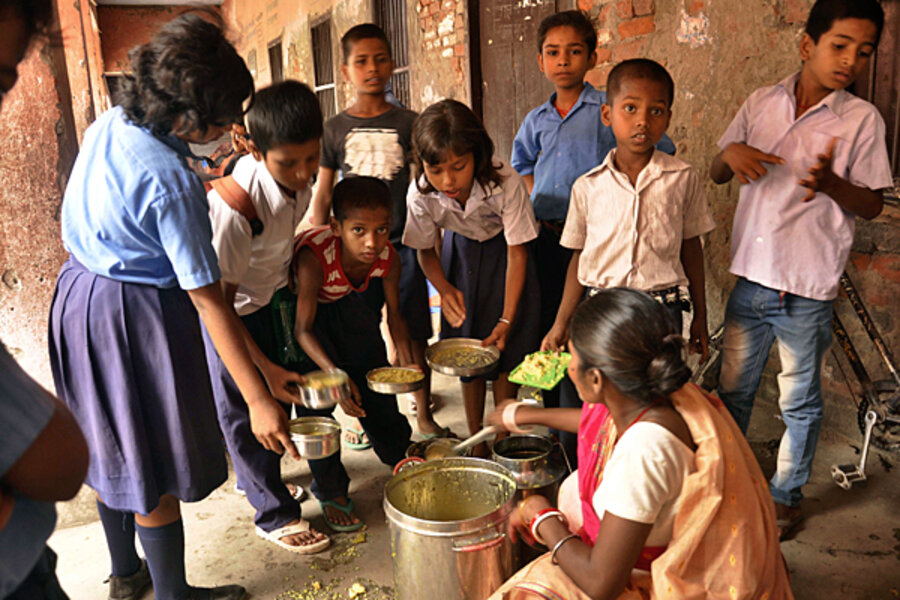Indian school lunch tragedy reveals problems with food safety
Loading...
• A daily roundup of global news reports.
The usually busy markets closed early today, and traffic is almost nonexistent in the town of Chapra, in India’s Bihar Province. But the streets are far from quiet. A bandh, or demonstration, has been called and protesters are out on the street, demanding answers for the tragedy that struck this small provincial city some 550 miles from New Delhi.
As of midday on Wednesday, 22 children – all under the age of 12 – have died after eating tainted government school lunch program meals, while dozens more are reported to be seriously ill. The deaths have shed light on serious problems with India's school meal programs, which are designed to increase attendance and combat India’s high rates of child malnutrition.
According to the Indian Express, the incident took place at a public elementary school in the Saran district of Bihar, about 15 miles away from Chapra. Traces of organophosphorus, an organic compound used in pesticides, were found in the meal served to students. One of the cooks is also reported to be ill.
The meals were part of the Mid-Day Meal Scheme, a government program aimed at encouraging school attendance by offering free food to pupils, reports the BBC. The program impacts some 120 million children across the country – making it one of the largest in the world – and is intended to not only increase literacy but also put a dent in India’s chronic malnutrition problem.
Despite India’s impressive economic growth, it is still home to approximately one third of all malnourished children in the world, according to the United Nations Children’s Fund (UNICEF). That’s more than all of sub-Saharan Africa.
Progress has been made on the issue. According to a report released in January 2012, India’s child malnutrition rate fell more than 10 points to 42 percent. While the figures are still alarmingly high, the government is starting to make attempts to fight child malnutrition, reports The Washington Post. India has seen large expansions in child welfare services and efforts to improve education in rural parts of the country.
Since the Mid-Day Meal Scheme was implemented in the 1960s it has been seen as a success overall, writes BBC’s Soutik Biswas. But gains made by the program have been marred by reports of corruption, negligence, and poor food inspection and hygiene, reports The Wall Street Journal:
“Staff had not been trained properly and lack the capacity to carry out proper monitoring,” said Yamini Aiyar, director of the Accountability Initiative at the Centre for Policy Research, a New Delhi-based think-tank that carried out the study. The study was published in June.
State government officials monitor the quality and delivery of meals to schools, but only district authorities can implement changes to the system and this can take considerable time, Ms. Aiyar said.
There have been other cases of children dying after eating school food. Two children from Panipat, in Haryana state, died in March after eating a free meal under the program. And in May, 18 girls from another district in Bihar state fell ill after eating a meal at school, according to the Hindu.
Still, none of the cases have been as grave as the recent tragedy in Bihar, where, according to the Times of India, students and parents have often complained about the quality of the food, having found dead lizards, insects, and a rat in the school-distributed meals.
Bihar’s chief minister, Nitish Kumar, has ordered an investigation, reports Reuters. He has also offered 200, 000 rupees ($3,400) to the families of victims as compensation.
This has done little to satisfy community members in Chapra, where violent protests have broken out amid speculation of foul play, reports the Telegraph.
The Telegraph's South Asia editor Dean Nelson said that allegations that the authorities took 15 hours to hospitalise the sick children led to dozens of residents taking to the streets in Chapra, pelting a police station with stones and setting ablaze buses and other vehicles.
"There have also been allegations that the cause of these death may have been deliberate, the government education minister in Bihar is saying this is not normal food poisoning," he added.







